- EasyCard
- Trade
- Help
- Announcement
- Academy
- SWIFT Code
- Iban Number
- Referral
- Customer Service
- Blog
- Creator
Comparing Hospital and Midwife Birth Costs for US Families

Image Source: pexels
When you plan on having a baby in the United States, the price can vary a lot depending on where and how you give birth. The average cost for a vaginal hospital birth is about $14,768, while cesarean sections cost around $26,280. If you choose a midwife-assisted birth at home or in a birth center, you may pay closer to $4,650. Insurance can help lower your out-of-pocket expenses, but it does not cover everything. You need to understand what is included in each birth package, from prenatal visits to care after your baby arrives. Your own pregnancy, where you live, and your insurance plan all affect what you will pay for childbirth. Most people in the US have their baby in a hospital, but more families are considering midwife-led options.
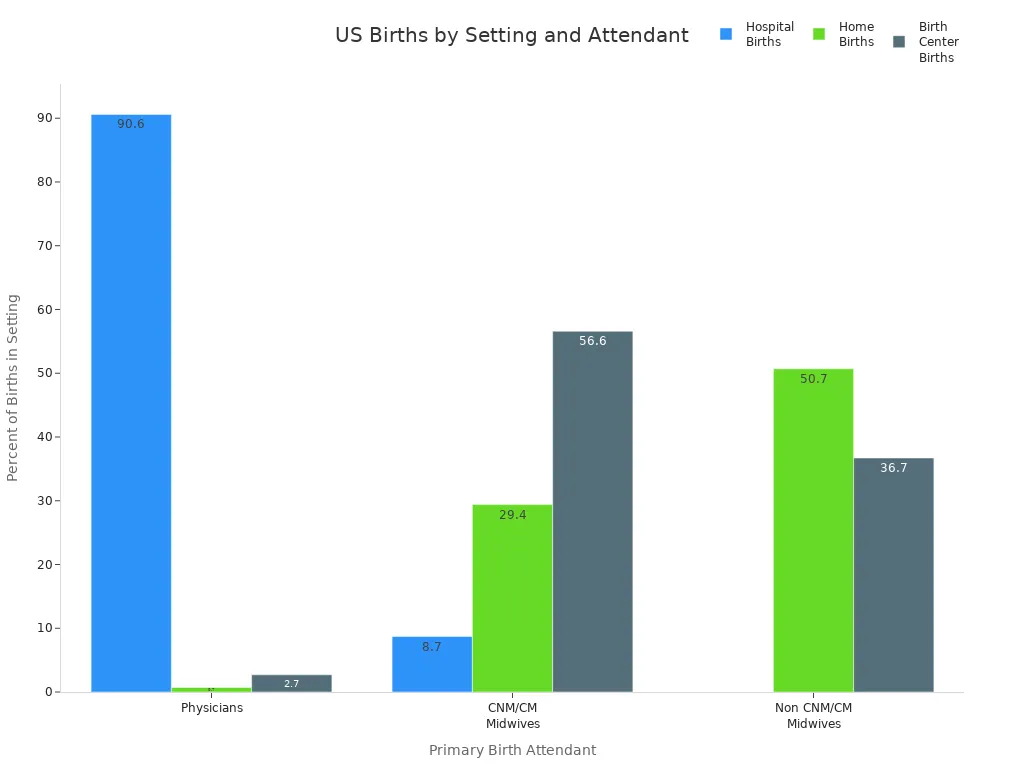
Key Takeaways
- Hospital births usually cost much more than midwife births, with average hospital vaginal deliveries around $14,768 and home midwife births about $4,650.
- Cesarean sections increase hospital birth costs significantly due to surgery and longer stays, while midwife births focus on natural delivery with fewer interventions.
- Insurance often covers hospital births well but may not cover home or birth center midwife births fully, so checking your insurance plan is essential.
- Planning your birth budget carefully, including asking providers about all costs and using tools like Health Savings Accounts, helps avoid surprise expenses.
- Extra support like doulas can improve your birth experience but usually costs extra and may not be covered by insurance, so explore payment options early.
Birth Cost Comparison

Image Source: pexels
Hospital Birth Costs
When you choose a hospital birth, you face some of the highest expenses for childbirth in the United States. The average cost for a vaginal delivery in a hospital is about $14,768, according to the Kaiser Family Foundation. If you need a c-section, the average cost rises to $26,280. These numbers include prenatal care, the delivery itself, and postpartum care for you and your baby. Insurance can help lower your out-of-pocket costs, but you still pay an average of $2,655 for a vaginal delivery and $3,214 for a c-section.
You can see the breakdown in the table below:
| Type of Birth | Average Total Cost (Including Insurance and Out-of-Pocket) | Average Out-of-Pocket Cost |
|---|---|---|
| Vaginal Delivery | $14,768 | $2,655 |
| Cesarean Delivery | $26,280 | $3,214 |
| Vaginal Delivery | $28,654 (Fair Health data) | N/A |
| Cesarean Delivery | $37,653 (Fair Health data) | N/A |
The cost of childbirth in a hospital can change based on where you live, your insurance plan, and if you have any complications. C-section cost is higher because it involves surgery, anesthesia, and a longer hospital stay. You also pay more if you need extra care for your baby after delivery.
Midwife Birth Costs
If you choose a midwife for your delivery, you usually pay less than you would for a hospital birth. The average cost for a home birth with a midwife is about $4,650. This price covers prenatal visits, the delivery, and care after your baby arrives. Some families pay as little as $2,000 or as much as $9,921, depending on the state and the midwife’s experience. Certified nurse midwives often charge more than certified professional midwives.
Birth centers offer another option. The average cost for a birth center delivery is $8,309. This includes professional fees, facility charges, and newborn care. Insurance coverage for midwife births is limited, so you may pay more out of pocket. Insured clients pay about 8.6% more than those without insurance.
Here is a table showing the average cost for different birth settings:
| Birth Setting | Average Cost (USD) | Cost Range (USD) | Notes |
|---|---|---|---|
| Home Birth (unweighted avg.) | $4,650 | $2,000 - $9,921 | Includes prenatal, delivery, postpartum care |
| Home Birth (weighted avg.) | $5,135 | N/A | Adjusted for state population sizes |
| Birth Center Birth | $8,309 | $1,811 - $18,399 | Includes professional, facility, newborn fees |
| Hospital Vaginal Birth | $13,562 | $8,321 - $19,459 | Includes all fees paid by insurers and patients with employer insurance |
You can see how home birth costs change by region in the chart below:
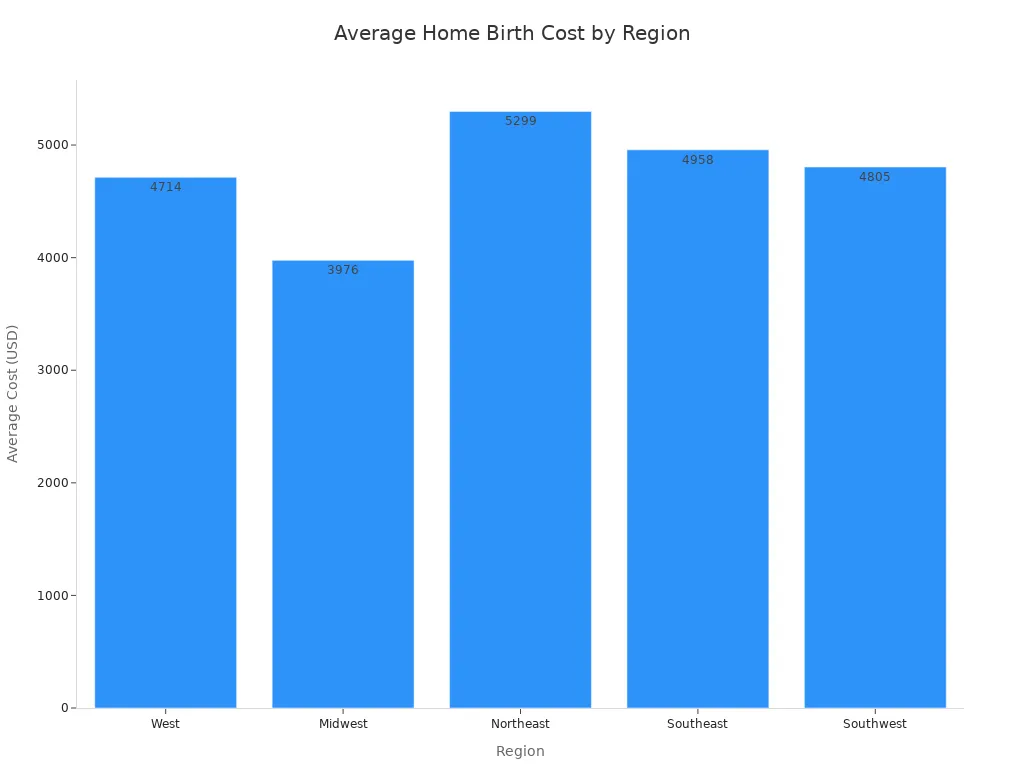
Key Differences
You notice big differences in the cost of childbirth when you compare hospital and midwife births. Hospital birth costs are much higher, especially if you need a c-section. Midwife-led births, whether at home or in a birth center, cost less because they use fewer medical interventions and have lower facility fees.
| Setting Type | Cost Range (USD, 2024 adjusted) | Cost Difference Compared to Hospital Births | Notes on Cost Components and Context |
|---|---|---|---|
| Midwife-Led Units | $129.84 (Bangladesh) to $9,571.58 (USA) | $14 to $6,051 less costly | Fewer interventions, lower facility costs |
| Hospital Births | $299.59 (Uganda) to $15,622.79 (USA) | Reference standard | More interventions, higher facility and professional fees |
| Home Births | $909.60 (Italy) to $5,356.58 (USA) | $555 to $10,266 less costly | Lower direct and indirect costs, fewer interventions |
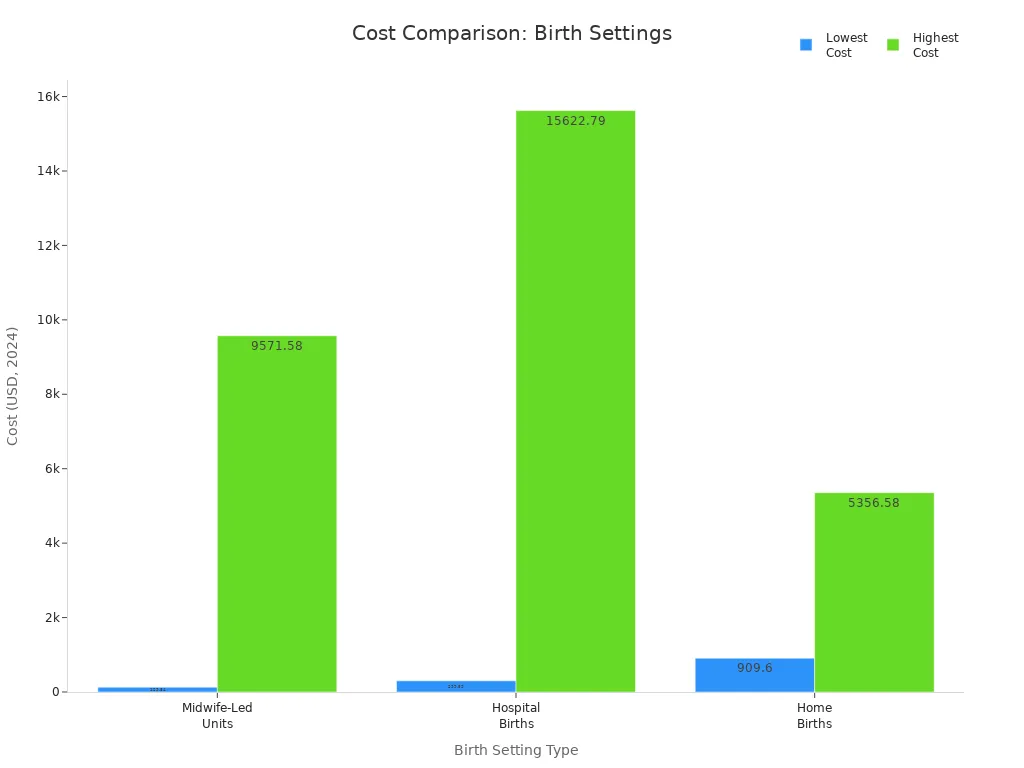
You also see differences in the rates of interventions. Hospital births often involve more c-sections, inductions, and epidurals. These interventions increase the total cost of delivery. Midwife-led care focuses on natural childbirth and reduces the need for surgery or medication. Studies show that midwife care leads to fewer c-sections and shorter hospital stays for you and your baby. This approach lowers the overall cost and can improve your recovery.
Note: The cost of childbirth depends on many factors, including your health, the type of delivery, and where you give birth. Always ask your provider for a detailed breakdown of costs before you make a decision.
What’s Included
Prenatal Care
You receive prenatal care throughout your pregnancy to monitor your health and your baby’s growth. In a hospital setting, obstetricians or family physicians provide prenatal care. They focus on identifying and managing risks during pregnancy. You may have regular checkups, ultrasounds, and lab tests. These visits often include routine screenings and advice about nutrition and exercise.
Midwife-led prenatal care centers on low-risk pregnancies and natural birth. Midwives offer checkups, education, and support. They encourage you to ask questions and take part in decisions. You may notice fewer routine tests and more time spent on your comfort and preferences.
Here is a comparison of what you can expect:
| Aspect | Hospital Birth (Physician-led) | Midwife Birth (CNMs, CPMs, CMs) |
|---|---|---|
| Prenatal Care | Regular visits, risk screening, ultrasounds, lab tests | Regular visits, education, support, fewer interventions |
| Provider | Obstetrician or family physician | Certified nurse midwife or professional midwife |
| Philosophy | Focus on risk management | Focus on natural pregnancy and birth |
Delivery Services
During delivery, hospitals offer a medicalized environment. You have access to interventions such as cesarean sections, fetal monitoring, and epidurals. Hospitals provide operating rooms and emergency care if needed. You may face more rules and restrictions, but you also have a wide range of pain relief options.
Midwife-led delivery services emphasize natural birth. You can choose your birthing position and have more family present. Pain relief options may include massage or acupuncture, but not epidurals. If complications arise, you may need to transfer to a hospital. Birth centers and home births focus on comfort and support, with fewer interventions.
Postpartum Care
After delivery, postpartum care helps you recover and supports your baby’s health. Hospitals usually provide immediate postpartum care. You may go home soon after birth and manage recovery on your own. Insurance often covers hospital postpartum care, but the support may feel limited.
Midwives offer personalized postpartum care. You get follow-up visits, breastfeeding support, and help with emotional health. Some states cover midwife postpartum care through Medicaid, but coverage varies. Midwives often visit you at home or in a birth center, making recovery more comfortable.
Tip: Ask your provider for a detailed list of what is included in your prenatal care, delivery, and postpartum care package. This helps you plan for your pregnancy and avoid unexpected costs.
Factors Affecting the Cost of Childbirth

Image Source: pexels
Type of Delivery
The type of delivery you have plays a big role in the total cost. Vaginal births usually cost less than cesarean sections. Cesarean deliveries require surgery, anesthesia, and longer hospital stays, which increase the cost. For example, a vaginal delivery without anesthesia costs about $1,936, while a cesarean section with induction can reach $5,639. Physician fees for cesarean deliveries also include extra charges for surgical assistants. Midwife-attended births are less expensive, with midwife care costing around $1,043 for attending delivery. You also see fewer newborn intensive care admissions and lower overall costs with midwife-led care.
| Delivery Type | Average Cost (USD) | Notes |
|---|---|---|
| Vaginal Delivery | $1,936 | No anesthesia, no major intervention |
| Cesarean Section | $5,639 | With induction, includes surgical fees |
| Midwife Attended | $1,043 | Attending delivery only |
Cesarean sections are about 50% more expensive than vaginal births. Avoiding unnecessary cesarean deliveries can help lower your cost of childbirth.
Location and Facility
Where you give birth affects the cost as well. Costs vary widely between states, cities, and even hospitals in the same area. For example, Mississippi has an average childbirth cost of $7,639, while California’s average is $19,230. In some metro areas, the price for the same delivery can range from $4,475 to $38,000. Hospitals with more market power often charge higher prices, but this does not always mean better care. Lack of price transparency makes it hard for you to predict your final bill.
| Geographic Location | Average Childbirth Cost (USD) | Notes |
|---|---|---|
| Mississippi (State) | $7,639 | Lowest average in the US |
| California (State) | $19,230 | Highest average in the US |
| Memphis, TN (Metro) | $4,475 - $17,113 | Wide price range within metro area |
| San Jose, CA (Metro) | $11,000 - $38,000 | Very large variation |
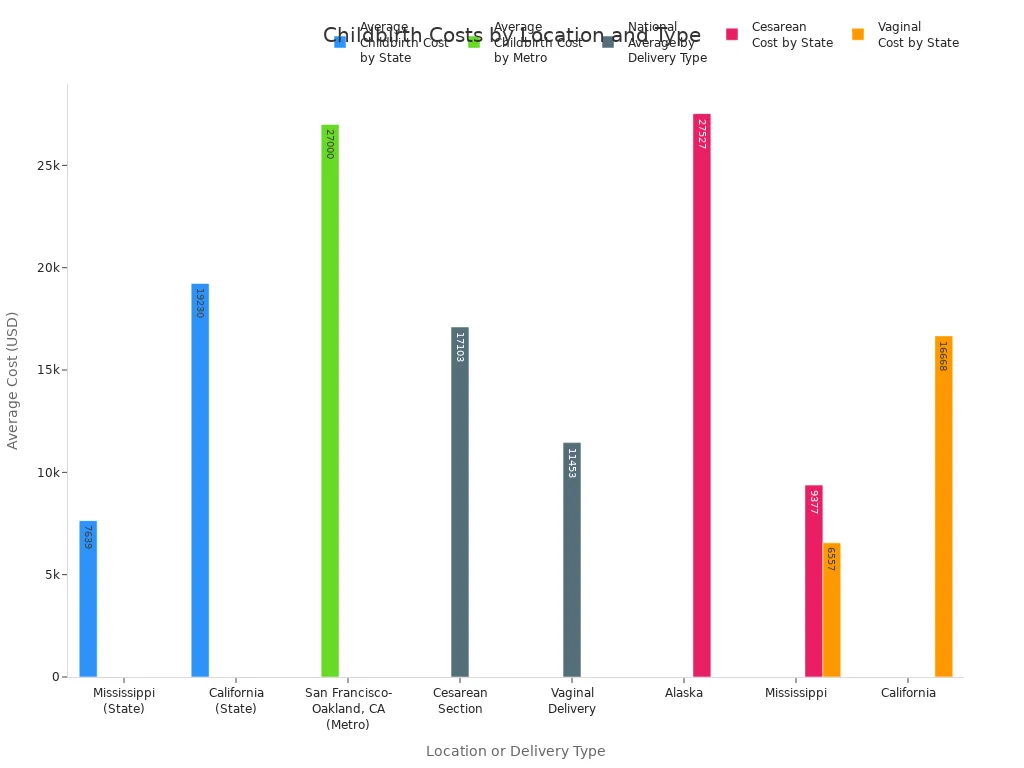
Provider and Team
The qualifications and experience of your provider also impact the cost. Physician-led hospital care often comes with higher rates of interventions, such as cesarean sections, which raise the cost. Midwife-led care, especially in birth centers, shows lower cesarean rates and fewer preterm deliveries. For example, the cesarean rate is 29.4% in physician-led care but only 19.7% in birth center care. Birth center care saves about $1,163 per delivery for Medicaid patients compared to hospital care. Lower payments to midwives and fewer interventions help reduce the overall cost.
| Aspect | Physician-led Care | Birth Center Care | Impact on Cost and Outcomes |
|---|---|---|---|
| Cesarean Section Rate | 29.4% | 19.7% | Lower C-section rate reduces costs |
| Preterm Delivery Rate | 11.0% | 7.9% | Fewer preterm births lower NICU costs |
| Average Medicaid Cost | $7,218 | $6,055 | Birth center care saves about $1,163 |
Insurance Coverage
Insurance plays a major role in what you pay for childbirth. Private insurance often leads to higher intervention rates and higher costs compared to Medicaid. Your health insurance coverage can affect both the intensity of care and the final bill. Hospital births usually have the most comprehensive insurance coverage. Midwife births in hospitals or birth centers may have moderate coverage, but home births often require you to pay out of pocket. Medicaid rarely covers home births. Changes in health insurance coverage and healthcare reform may change future costs and quality of care. Out-of-pocket costs can range from under $1,000 in some states to over $2,500 in others, depending on your insurance plan.
| Birth Setting | Insurance Coverage Details |
|---|---|
| Hospital Births | Most common, comprehensive coverage, some midwife and doula services included |
| Midwife Births | Coverage varies, more likely if in hospital or birth center |
| Home Births | Limited or excluded, many insurers consider home births risky, Medicaid rarely covers |
| Birthing Centers | Increasing but inconsistent coverage, depends on insurer and location |
Tip: Always check your health insurance coverage before choosing your provider or birth setting. This helps you avoid unexpected costs and plan your budget.
Insurance and Delivery Costs
Hospital Birth Insurance
Insurance plays a big role in what you pay for a hospital birth. Most families use employer-sponsored plans, Medicaid, or Marketplace plans for health insurance coverage. The Affordable Care Act (ACA) requires these plans to cover pregnancy, childbirth, and newborn care as essential health benefits. You get prenatal visits, delivery, and well-baby checkups included. Some preventive services come with no out-of-pocket expenses. However, you still face hospital bills for things like ultrasounds or baby supplies, which are not always covered. On average, families with employer-sponsored insurance pay about $1,905 out-of-pocket for delivery. Medicaid covers most costs for eligible families, often with little or no cost-sharing. The total first-year cost, including postpartum care and supplies, can reach $16,391 for insured families.
| Category | Details |
|---|---|
| Insurance Coverage | Pregnancy, childbirth, and newborn care are essential health benefits under the ACA, covered by employer-sponsored plans and Medicaid. |
| ACA Requirements | Coverage must include prenatal visits, childbirth, and well-baby visits without out-of-pocket costs for preventive services. |
| Coverage Gaps | Some services like ultrasounds and baby supplies may not be fully covered, leading to extra expenses. |
| Average Out-of-Pocket Delivery Cost | $1,905 nationally (employer-sponsored insurance) |
| Medicaid Coverage | Low or no cost-sharing for eligible low-income families |
Midwife and Home Birth Insurance
Insurance for midwife and home birth options is less predictable. Many states do not require insurers to cover home births, and some plans exclude them. You may find that health insurance coverage for midwife services is lower than for hospital birth. Birth centers and midwives often receive lower payments than hospitals for the same services. Some states limit the number of prenatal visits covered, even though birth centers usually offer more. If you need to transfer to a hospital during labor, insurance may not pay for the midwife’s labor care. Administrative rules and state laws can make it hard for birth centers to join insurance networks. In some cases, families pay thousands of dollars out-of-pocket for home births because insurance denies claims. About 90% of home birth insurance claims require appeals. Even when insurers say they cover home births, details are often unclear.
| Insurance Challenge Category | Examples and Details |
|---|---|
| Inadequate reimbursement rates | Midwives paid less than physicians; birth centers receive lower payments than hospitals |
| Coverage limitations | Many states do not cover home births, lactation consultants, or childbirth education |
| Administrative burden | Birth centers face challenges with insurance contracts and claims submission |
Reducing Out-of-Pocket Costs
You can take steps to lower your childbirth expenses. Many hospitals and birth centers offer payment plans, letting you spread out hospital bills over time. Using a Health Savings Account (HSA) helps you pay with pre-tax dollars. Some insurance plans reimburse you for childbirth classes, breastfeeding support, or newborn care classes, which can reduce extra costs. Tax benefits for families with children can also help with expenses. Crowdfunding has become a way for some families to manage unexpected costs. If you have questions about your health insurance coverage, ask your provider or insurance company for a detailed breakdown. Understanding your plan helps you avoid surprises and plan for the total cost of childbirth.
Tip: Review your insurance plan before your due date. Ask about what is covered, what is not, and how to appeal denied claims. Planning ahead can help you manage hospital birth and midwife expenses more confidently.
Extra Childbirth Expenses
Doulas and Support Services
You may want extra support during childbirth. Doulas offer physical and emotional help before, during, and after birth. Their services can make your experience more comfortable and less stressful. Costs for doulas vary based on experience, location, and the type of care you need. Some birth doulas charge a flat fee, while postpartum doulas often use hourly rates. You can see typical costs in the table below:
| Doula Type | Cost Range (USD) | Pricing Model | Notes |
|---|---|---|---|
| Birth Doula | $500 - $2,500 per birth | Flat fee per birth | Lower in smaller towns, higher in cities |
| Postpartum Doula | $25 - $75 per hour | Hourly rate | Higher for overnight or multiple babies |
| Overnight Postpartum | $250 - $650 per night | Hourly rate | 8-10 hour shifts |
| Virtual Doula | Around $100 per hour | Varies | Newer option, price varies |
Some doulas offer sliding scale fees or payment plans. Community programs and grants can help lower your out-of-pocket costs. Insurance coverage for doula care is limited, but some Medicaid programs now reimburse these services. Using a Health Savings Account (HSA) or Flexible Spending Account (FSA) may also help cover doula expenses.
Tip: Ask doulas about their experience, included services, and payment options. This helps you find support that fits your needs and budget.
Supplies and Unexpected Fees
You may face extra costs for supplies and unexpected fees during childbirth. Hospital births often include charges for anesthesia, doctor fees, medical supplies, and room and board. If you need a C-section or extra care, your bill can increase quickly. Sometimes, billing errors or out-of-network providers add surprise expenses.
For midwife births, you usually pay a fixed fee, but you may need to buy a birth supply kit, which costs about $130. Other possible expenses include lab work, ultrasounds, or birth tub rental. If you need to transfer to a hospital, you will pay both midwife and hospital fees. The table below shows common extra costs:
| Birth Setting | Common Extra Costs (USD) | Notes |
|---|---|---|
| Hospital Birth | Anesthesia, doctor fees, supplies, C-section, induction | Charges may include copays, deductibles, and coinsurance |
| Midwife Birth | Birth kit ($50-$300), lab work ($100-$500), tub rental ($100-$400), hospital transfer fees | Some services not included in midwife fee |
You can lower your expenses by asking for a detailed list of what is included in your care package. Always check with your provider and insurance company to avoid surprises.
Budgeting for Hospital Birth and Midwife Care
Creating a Birth Budget
Planning for a new baby means preparing for many expenses. You need to think about all the costs that come with birth, not just the hospital or midwife fees. Start by listing out-of-pocket healthcare costs, such as ultrasounds, prenatal vitamins, and parenting classes. Add in maternity clothes and baby gear like a crib, car seat, and stroller. Remember to include diapers and baby-proofing items. If you expect unpaid parental leave, try saving sick days or vacation time to help cover your income gap. Some states offer paid leave, and short-term disability insurance can help if you have a difficult pregnancy. Building an emergency fund gives you a safety net for unexpected costs.
| Category | Example Costs (USD) |
|---|---|
| Crib | $150–$350 |
| Car Seat | $75–$200 |
| Diapers (monthly) | $150–$275 |
| Stroller | $120–$450 |
| Out-of-pocket Birth | $2,655–$3,214 |
Questions to Ask Providers
Before you choose a birth setting, ask your provider and insurance company important questions. This helps you avoid surprise bills and understand your coverage. Here are some key questions:
- Do you need a referral to see a specialist or OBGYN?
- What birth costs does your insurance cover?
- What are your copay, coinsurance, and deductible amounts?
- Are prenatal tests like ultrasounds covered?
- Do you need preauthorization for care or delivery?
- Does your plan cover midwife or home birth options?
- Will you have a private room during birth?
- Are all providers and the hospital in-network?
- Can you negotiate costs or get self-pay rates if you are uninsured?
Asking these questions gives you a clear picture of your financial responsibilities.
Saving on Childbirth Costs
You can save on birth costs without lowering the quality of care. Choose bundled packages for services when possible, as this can reduce overhead. Practice living on a reduced income before your baby arrives to adjust your budget. Buy second-hand baby items like clothes and strollers, but always get a new car seat for safety. Use community resources and support groups for parenting classes or breastfeeding help. Facility-based births with skilled attendants, such as midwives, can be more cost-effective than home visits. Build a financial buffer for emergencies, and review your insurance plan to make sure you get the best coverage for your birth needs.
When you compare costs, having a baby in a hospital often costs much more than with a midwife. See the table below for clear differences:
| Scenario | Hospital Cost | Home Birth Cost | Home as % of Hospital |
|---|---|---|---|
| Low-risk birth | $2,204 more | — | 45.9% |
| Uncomplicated vaginal birth | $2,505 more | — | 35.1% |
Understanding what is included in your care and how insurance works helps you plan for having a baby. You can take steps like checking insurance details, asking about all costs, and using support programs. Careful planning lets you manage childbirth costs with confidence.
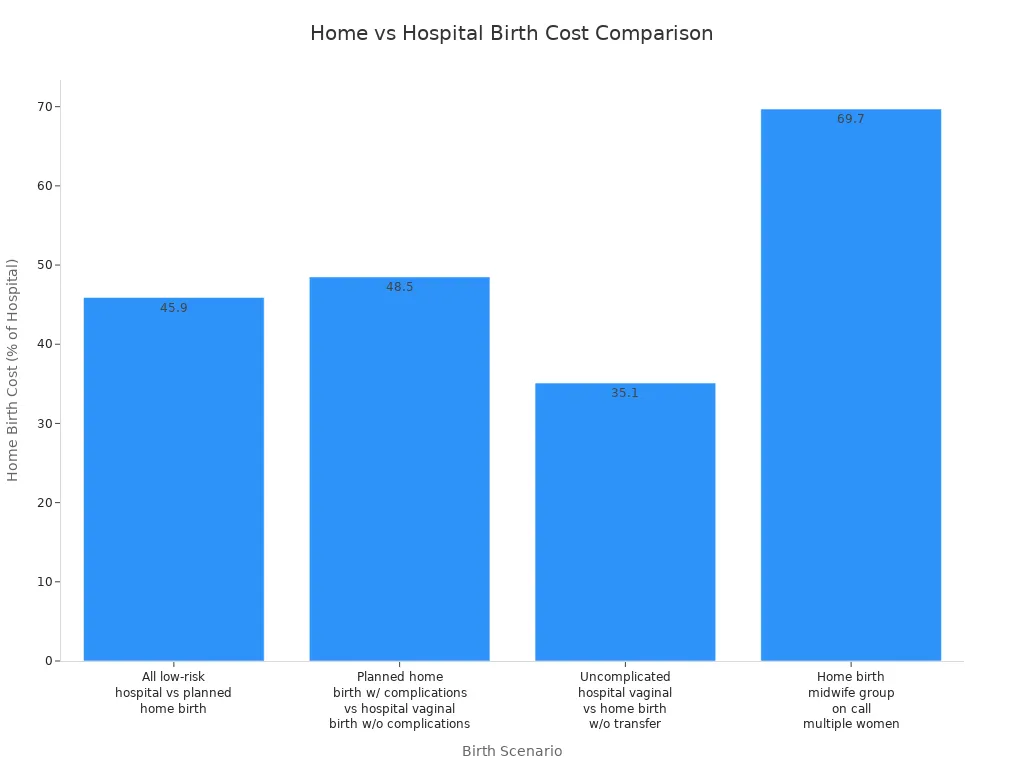
FAQ
What is the main difference between hospital and midwife birth costs?
You usually pay much more for a hospital birth than for a midwife birth. Hospital births often cost over $14,000. Midwife births at home or in a birth center can cost less than $5,000. Insurance may cover some costs.
Does insurance always cover home or birth center births?
Insurance does not always cover home or birth center births. Many plans only cover hospital births. Some states require coverage for birth centers, but not all. Always check your plan before you decide.
Can you use a Health Savings Account (HSA) for childbirth expenses?
Yes, you can use an HSA to pay for many childbirth expenses. This includes hospital bills, midwife fees, and some supplies. Using an HSA helps you save on taxes.
What happens if you need to transfer from a home birth to a hospital?
If you transfer to a hospital during labor, you may pay both the midwife and hospital fees. Insurance may not cover all costs. Ask your provider about possible transfer fees before you choose your birth plan.
Are doulas covered by insurance?
Most insurance plans do not cover doula services. Some Medicaid programs in certain states may pay for doulas. You can sometimes use an HSA or Flexible Spending Account (FSA) to help pay for a doula.
Planning for childbirth already brings enough stress—don’t let high and unpredictable costs add to it. Hospital births in the U.S. average $14,000–$26,000, while midwife-assisted home births can be as low as $4,650. With BiyaPay, you can send funds internationally to cover these essential medical expenses faster, cheaper, and with full transparency. Use our real-time exchange rate tool to know exactly what your family receives. Enjoy remittance fees as low as 0.5%, same-day remittance with same-day arrival, and the ability to convert between multiple fiat and digital currencies. With coverage across most countries worldwide, BiyaPay ensures your loved ones get the support they need without unnecessary financial strain.
Start supporting your family’s maternity care today with BiyaPay
*This article is provided for general information purposes and does not constitute legal, tax or other professional advice from BiyaPay or its subsidiaries and its affiliates, and it is not intended as a substitute for obtaining advice from a financial advisor or any other professional.
We make no representations, warranties or warranties, express or implied, as to the accuracy, completeness or timeliness of the contents of this publication.




Contact Us
Company and Team
BiyaPay Products
Customer Services
is a broker-dealer registered with the U.S. Securities and Exchange Commission (SEC) (No.: 802-127417), member of the Financial Industry Regulatory Authority (FINRA) (CRD: 325027), member of the Securities Investor Protection Corporation (SIPC), and regulated by FINRA and SEC.
registered with the US Financial Crimes Enforcement Network (FinCEN), as a Money Services Business (MSB), registration number: 31000218637349, and regulated by FinCEN.
registered as Financial Service Provider (FSP number: FSP1007221) in New Zealand, and is a member of the Financial Dispute Resolution Scheme, a New Zealand independent dispute resolution service provider.



















